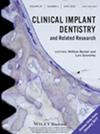Accuracy of Two Robotic Computer-Aided Implant System Registration Methods for Dental Implantation: A Prospective Study
Abstract
Background
Robot-assisted implant surgery has been shown to achieve high levels of accuracy. However, there is currently a paucity of clinical studies evaluating the accuracy of marker-based intraoral scanner (IOS) registration (IR) methods.
Purpose
The purpose of this study was to compare the accuracy of the marker-based cone beam computed tomography (CBCT) registration (CR) method and the IR method in the dental implant in the robotic computer-aided implant system (R-CAIS).
Materials and Methods
This retrospective study included 20 participants, with 10 undergoing implant surgery using the CR method within a robotic system, and the remaining 10 receiving implants using the IR method. Preoperative CBCT images used for implant planning were aligned with the postoperative CBCT images to assess and quantify positional deviations in implant placement. The primary outcome measures were FRE, entry deviation, apical deviation, and angular deviation. A Student's t-test was performed to compare differences between the two groups, with a p-value of < 0.05 considered statistically significant.
Results
The mean ± standard deviation values for FRE were 0.027 ± 0.007 mm for the CR group and 0.031 ± 0.006 mm for the IR group (p = 0.149). The mean ± standard deviation values for entry deviation were 0.58 ± 0.11 mm for the CR group and 0.53 ± 0.15 mm for the IR group (p = 0.072). The mean ± standard deviation values for apical deviation were 0.52 ± 0.12 mm for the CR group and 0.50 ± 0.14 mm for the IR group (p = 0.730). The mean ± standard deviation values for apical deviation were 1.10 ± 0.34 mm for the CR group and 1.17 ± 0.23 mm for the IR group (p = 0.730).
Conclusions
In R-CAIS, the IR method demonstrated accuracy comparable to that of the CR method, with both methods yielding clinically satisfactory outcomes.

 求助内容:
求助内容: 应助结果提醒方式:
应助结果提醒方式:


